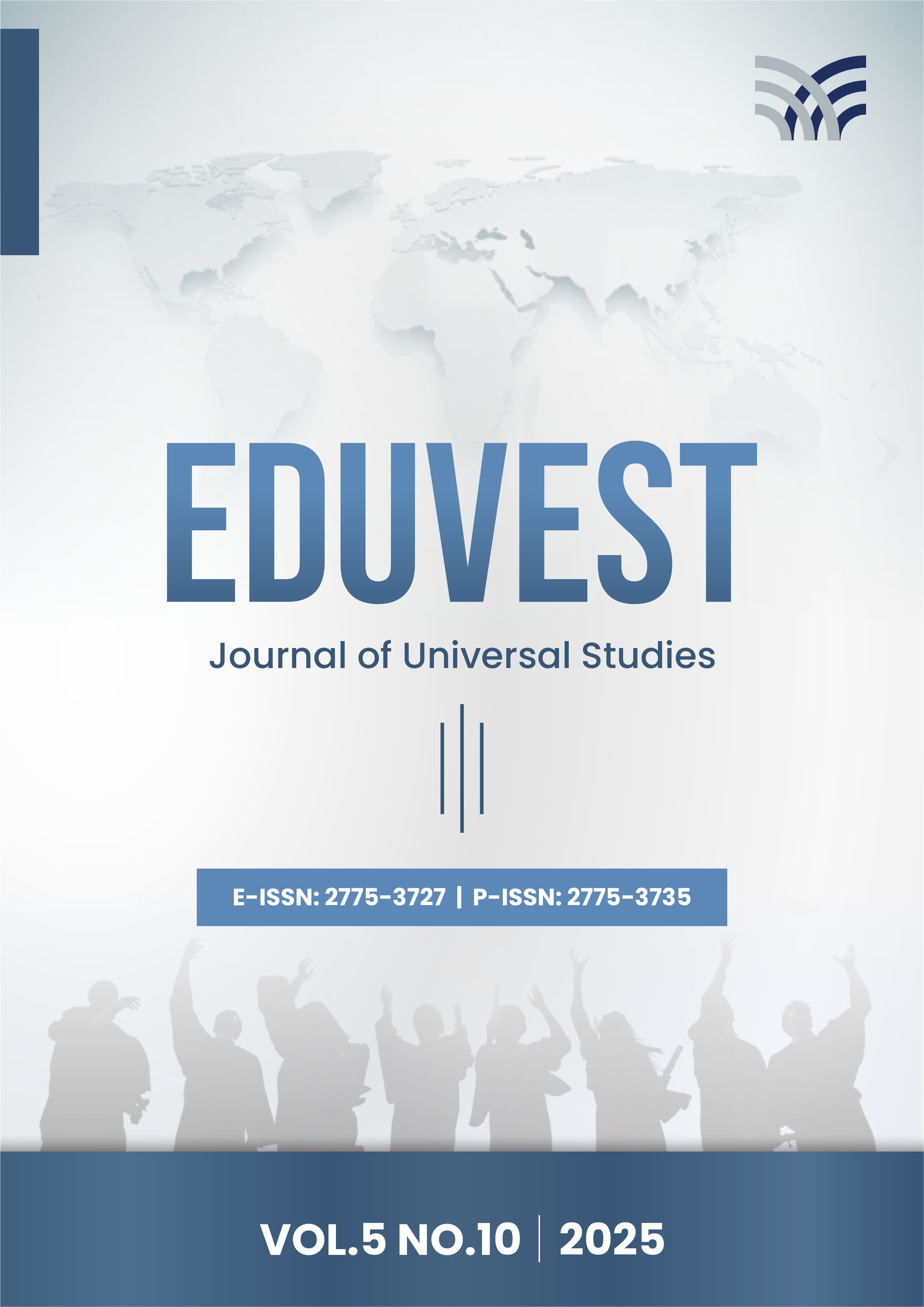The Influence of Safety Communication on Safety Culture and Operational Excellence in High-Risk Industries
##semicolon##
https://doi.org/10.59188/eduvest.v5i10.52134##semicolon##
Safety Communication##common.commaListSeparator## Safety Culture##common.commaListSeparator## Operational Excellence##common.commaListSeparator## High-Risk Industry##common.commaListSeparator## Oleochemical Sector##common.commaListSeparator## Employee EngagementAbstrakt
Industrial sectors categorized as high-risk industries, such as oleochemical manufacturing, are increasingly exposed to multiple hazards and safety-related challenges due to process complexity, the use of hazardous materials, and the critical role of human behavior. This research aims to examine the influence of safety communication on safety culture and operational excellence in high-risk industries within PT SCM, a leading oleochemical company in Indonesia. The objective of this study is to empirically determine the extent to which safety communication serves as a determinant in shaping safety-related behavior and enhancing organizational performance in high-risk plants. Utilizing a quantitative research design, data were gathered from 421 employees through structured questionnaires and subsequently analyzed using Structural Equation Modeling (SEM). The findings indicate that safety communication exerts a statistically significant impact on the internalization of safety culture (β = 0.724, p < 0.001) and contributes both directly (β = 0.368) and indirectly (β = 0.317) to the attainment of operational excellence. Furthermore, the analysis reveals that direct communication approaches, such as safety briefings, safety talks, and management walk-throughs, are more effective than symbolic or non-verbal modes. The study concludes that safety communication is not merely an administrative tool but a strategic organizational mechanism, essential for fostering employee engagement, reinforcing safe behavior, and sustaining high-performance outcomes within the organization.
##submission.citations##
Codier, E., & Codier, D. (2015). A model for the role of emotional intelligence in patient safety. Asia-Pacific Journal of Oncology Nursing, 2(2), 112–117. https://doi.org/10.4103/2347-5625.157594
Dasgupta, A., Islam, M. M., Nahid, O. F., & Rahmatullah, R. (2024). Engineering Management Perspectives On Safety Culture In Chemical And Petrochemical Plants: A Systematic Review. Academic Journal On Science, Technology, Engineering & Mathematics Education, 1(01), 36–52. https://doi.org/10.69593/ajieet.v1i01.121
Elvik, R. (2016). A theoretical perspective on road safety communication campaigns. Accident Analysis and Prevention, 97, 292–297. https://doi.org/10.1016/j.aap.2015.04.027
Forsthoffer, W. E. (2011). Implementation and Communication Best Practices. In Forsthoffer’s Best Practice Handbook for Rotating Machinery (pp. 577–587). Elsevier. https://doi.org/10.1016/b978-0-08-096676-2.10012-8
Haas, E. J., & Yorio, P. L. (2021). Behavioral safety compliance in an interdependent mining environment: Supervisor communication, procedural justice and the mediating role of coworker communication. International Journal of Occupational Safety and Ergonomics, 27(4), 1088-1100. https://doi.org/10.1080/10803548.2021.1896140
Herbert, K., Boyle, T., Jiang, K., & Zhao, X. (2024). Safety leadership: A bibliometric literature review and future research directions. Journal of Business Research, 170, Article 114340. https://doi.org/10.1016/j.jbusres.2023.114340
Imandiya, K., Zulkarnain, M., Novrikasari, & Noviadi, P. (2024). Persepsi Pekerja dalam Budaya Keselamatan dan Kesehatan Kerja: Studi Kasus di Industri Berisiko Tinggi: Literature Review. Media Publikasi Promosi Kesehatan Indonesia (MPPKI), 7(1), 65–72. https://doi.org/10.56338/mppki.v7i1.4287
Lestari, Puji (2023), Teori Komunikasi Hati, Analisis dan Implementasi dalam Kehidupan, LPPM UPN Veteran, Jogjakarta
Liu, W., Hu, Y., & Huang, Q. (2024). Research on Critical Factors Influencing Organizational Resilience of Major Transportation Infrastructure Projects: A Hybrid Fuzzy Dematel-Ism-Micmac Approach. Buildings, 14(6). https://doi.org/10.3390/buildings14061598
Lyu, S., Xi, J., Cui, P., Zhang, R. P. H., Jiang, X., & Zhang, B. (2025). Understanding the effects of supervisory and coworker safety communication on construction workers' behavior. Frontiers in Public Health, 13, Article 1660513. https://doi.org/10.3389/fpubh.2025.1660513
Naji, G. M. A., Isha, A. S. N., Alazzani, A., Saleem, M. S., & Alzoraiki, M. (2022). Assessing the Mediating Role of Safety Communication Between Safety Culture and Employees Safety Performance. Frontiers in Public Health, 10. https://doi.org/10.3389/fpubh.2022.840281
Quach, E. D., Kazis, L. E., Zhao, S., Ni, P., Clark, V. A., McDannold, S. E., & Hartmann, C. W. (2021). Organizational readiness to change as a leverage point for improving safety: a national nursing home survey. BMC Health Services Research, 21(1). https://doi.org/10.1186/s12913-021-06772-y
Sadia, A., Mohd Salleh, B., Abdul Kadir, Z., & Sanif, S. (2016). The Relationship between Organizational Communication and Employees Productivity with New Dimensions of Effective Communication Flow. Journal of Business and Social Review in Emerging Economies, 2(2), 93–100. https://doi.org/10.26710/jbsee.v2i2.35
Sari, F. M., Yusnadi, Y., & Samosir, H. E. (2023). Struktur Sosial Komunikasi Organisasi dalam Perspektif Klasik, Humanis, Integratif, dan Kontemporer. Jurnal Ilmu Sosial Dan Ilmu Politik Malikussaleh (JSPM), 4(2), 334. https://doi.org/10.29103/jspm.v4i2.12415
Silaen, T. S., Baga, L. M., & Kirbrandoko, K. (2018). Reformulasi Strategi untuk Meningkatkan Budaya Keselamatan Kerja di PT XYZ. Jurnal Aplikasi Bisnis Dan Manajemen, 63–72. https://doi.org/10.17358/jabm.4.1.63
Tawfeeq, O. M., Thiruchelvam, S. A. L., & Abidin, I. B. Z. (2024). Impact of Safety Management Practices on Safety Performance in Workplace Environment: A Case Study in Iraqi Electricity Production Industry. Engineering, Technology and Applied Science Research, 14(2), 13539–13546. https://doi.org/10.48084/etasr.7006
Vikan, M., Haugen, A. S., Bjørnnes, A. K., Valeberg, B. T., Deilkås, E. C. T., & Danielsen, S. O. (2023). The association between patient safety culture and adverse events – a scoping review. BMC Health Services Research, 23(1). https://doi.org/10.1186/s12913-023-09332-8
Wang, D., Wang, L., Wei, S., Yu, P., Sun, H., Jiang, X., & Hu, Y. (2022). Effects of Authoritarian Leadership on Employees’ Safety Behavior: A Moderated Mediation Model. Frontiers in Public Health, 10. https://doi.org/10.3389/fpubh.2022.846842
Zara, J., Nordin, S. M., & Isha, A. S. N. (2023). Influence of communication determinants on safety commitment in a high-risk workplace: a systematic literature review of four communication dimensions. In Frontiers in Public Health (Vol. 11). Frontiers Media SA. https://doi.org/10.3389/fpubh.2023.1225995
##submission.downloads##
Publikované
##submission.howToCite##
Číslo
Sekcia
##submission.license##
##submission.copyrightStatement##
##submission.license.cc.by-sa4.footer##










